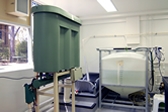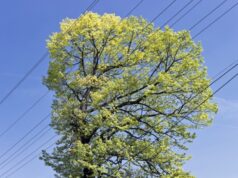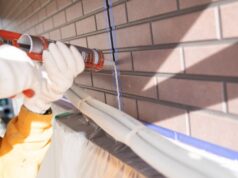
Just because water from the tap has been used, it doesn’t mean it can’t be used again. See how grey water systems can help reduce your water waste.

What is grey water?
Grey water is water that’s already been used for another purpose in your home, collected for reuse for other purposes (most commonly to water plants, but also to flush toilets or do laundry). Probably the best place to start when talking about grey water is to discuss what it isn’t. Grey water is not potable – by law you cannot drink it, even if your treatment system has theoretically purified it to drinking water quality.
If you want to use it for anything other than watering your plants (excluding the veggie garden), it’s critical that grey water be treated, as all of the harmful detergents and cleaners need to be removed. As a result, grey water comes in all different qualities – and it’s a good idea to understand where your grey water is coming from. Below are a few grey water sources:
- The bathroom basin. Wash basins generally contain soap, toothpaste, mouthwash and hair – not so tasty.
- The kitchen sink. Your sink or dishwasher is generally infested with soap, detergents, food scraps, grease and oils.
- The laundry. Laundry water is said to be rife with phosphorous and sodium salts. It also contains soaps, detergents, water softeners, bleaches, lint, skin cells and even faecal matter.
- Shower and bath water. Similar to the laundry in terms of contaminants. Add shampoo, skin and the chemicals and disinfectants used to clean this area.
Using grey water for the wrong things will make people sick, so if you are handling it either through pipes, as runoff or using it to grow your own food, you need to make sure that nobody is exposed to any associated risks. In essence, don’t use untreated grey water for anything that can harm yourself or other people.
The benefits of grey water
Despite the cautions that come with grey water use, it does have serious advantages in terms of efficiency. It provides a regular supply of water and while it is dependent on the capacity of your storage system or weather, grey water is produced every day. Grey water can be used to help your garden flourish, and if treated properly can also be used to flush the toilet or wash your clothes. Grey water is particularly useful in areas where water restrictions are often in place like Melbourne, and in summer can mean the difference between a healthy garden and one that’s dying of thirst.
Grey water diversion
There are several ways you can divert your grey water. A garden hose is a handy diversionary tool. If your laundry is situated near your garden, attach the laundry outlet hose to an extension hose (they need to be the same diameter as your outlet hose to avoid straining the pump), and direct the water to a mulched garden bed, as the mulch helps to prevent run off. A small submersible pump can pump water from a bath or laundry to your garden. To use a submersible pump connect a hose to the pump outlet and run this to your garden. You will need to manually switch the pump on or off unless you purchase a 240V model which can run automatically.
Gravity or pump
If you want to get a little more technical and you have access to the drain outlet pipes from the shower, bath or laundry, then you can get a plumber to install diverter valves that, using either a pump or gravity, will automatically send your grey water to the garden. This valve gives you the option of diverting water to the garden in dry weather or sending it to the sewer in wet weather. The valve will need to be connected to a drainage pipe.
This kind of setup will need to be installed by a plumber, as the wastewater pipe will need to be disconnected. They must be installed at an accessible point. While your plumber is installing the valve, ask them to install an outlet pipe that separates your grey water from the sewer pipe. If you have an outlet pipe, you can use a rubber funnel for grey water diversion. The funnel inserts into the elbow joint of the outlet pipe. A 19mm polypipe is then attached to the funnel and the water is dispersed. This is a gravity-based method.
Grey water treatment
If you want to go a step further with your grey water re-use, it is time to look into treatment systems. You will need a treatment system for toilet flushing, laundry, or watering the vegetable garden. Treatment systems are a lot more expensive than diversion systems, but can save you money in the long term.
Treatment systems improve the quality of grey water and allow long term storage of the treated water. There are treatment systems that produce water clean enough to store indefinitely in tanks (separately to rainwater) but you will find that most storage systems dump the treated water every 24 hours or so – different manufacturers have systems that do different things.
There are two types of treatment:
- Treatment without disinfection. Used for sub-surface irrigation and some toilet use. Grey water diversion without disinfection usually includes mesh filters to capture hair or lint, but they don’t treat the water to remove biological or chemical contamination. Using this system means you cannot store the water.
- Treatment with disinfection. Used for non-permanent water-storage, allows for irrigation of vegetables and toilet flushing or laundry.
Treatment systems don’t have to be large – in fact they can be the same size as a slimline water tank. Other systems are installed underground. The system includes a tank that holds the grey water. This may be the same tank that treats the water, however a separate tank is usually used.
The treatment process
Treatment processes for grey water are generally broken down into one of two categories:
- Mechanical systems – these include things like sand filtration, lava filtration and UV treatment
- Biological systems – plant-based systems, bio-reactors and other methods that rely on microorganisms to consume the contaminants in the water
Disinfection of grey water allows for it to be used for any sort of above ground irrigation, and for general household use on things like laundry. If you have a dual tank, the treated water will be pumped into a second tank for storage. Even treated grey water should not be mixed with rain water, though.
Check with your local authority before you have a plumber install a treatment tank. Strict rules and regulations apply, and sites need to be approved by the EPA and a storage tank permit is required. To receive approval, the tank needs to meet specific standards. In Victoria, this is the 20/30/10 standard to allow surface irrigation. This refers to 20ml per litre for Biochemical Oxygen Demand (BOD), 30ml per litre for Suspended Solids (SS) and 10 organisms per 100ml for E.coli.
A quick note about blackwater
Blackwater, in the simplest terms, is waste water from your toilet. Most blackwater treatment systems are aeration systems, which aerate the sewerage and allow bugs to eat the solids. From here, the water is then pumped into a pump-out chamber. The water quality is generally very high after this process.
Having said that, blackwater systems are still in their infancy in terms of acceptance with households. At the moment, blackwater can only be used for irrigation in some states – not for toilets. The treatment systems are limited to below ground irrigation in certain States too, and require very strict regular maintenance. Check with your local council to find out more about what’s involved.





